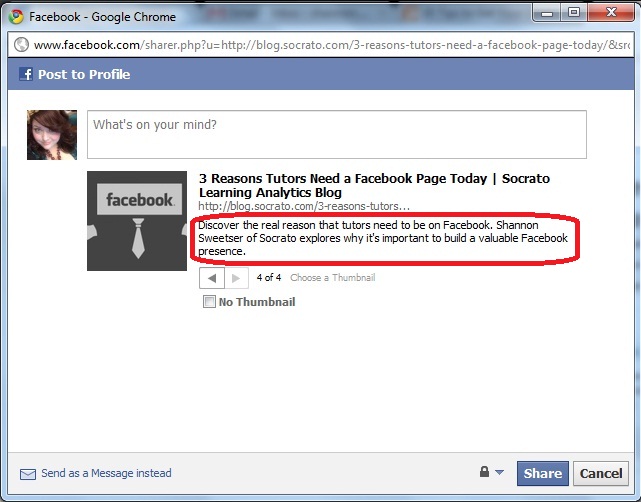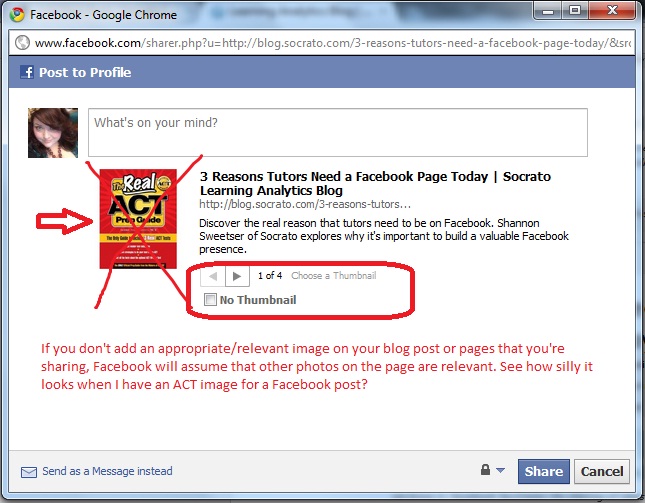Is your company’s Facebook page getting the traffic you desire or the attention you believe it deserves?
Before you ask yourself “What went wrong?” read the following blog post. It’s a Facebook guide for tutors and it may just help you turn your Facebook page from a lifeless desert into a hub that your fans love to interact with.
To get started engaging your Facebook fans, here are common mistakes I see tutoring companies make on Facebook and some action items on how to fix them.
Mistake # 1: Your Business has Friends, not Fans, on Facebook.
“What’s so wrong about asking to be someone’s friend on Facebook?” you may ask. There’s nothing wrong with being friends with people on Facebook if you’re a person with their own private account and network of friends. However, your business should not have friends, it should have fans who have liked your business on Facebook. Brand personalities (Celebrities) and businesses such as tutoring companies should maintain their presence on Facebook through a business page; it comes with a different suite of tools than a Facebook friend account and is geared to help businesses. For one, if you have a Facebook Page, fans can “like” your page whenever they want instead of having to wait for a friend request to go through from you.
The Solution: Create a Facebook Page for your business using Facebook’s step-by-step Page creation guide. Start migrating your “friends” on Facebook and ask them to “Like” your business page. To sweeten the deal, you may want to offer the opportunity for any one who Likes your new Facebook page by X date has a chance to win an iPod touch or other attractive prize. You may want to also continue to use both pages in coordination with one another continually reminding people at various times during the next few weeks to “Like” your Facebook page and then provide a link. Moving forward, you’ll want to move all of your marketing efforts over to the Facebook page you created rather than the Facebook friend page you previously used. If Facebookers continue to add you as a friend on that account, send them a nice message asking them to “Like” your Facebook page instead to get updates.
Mistake # 2: You Forget to Write an Appealing Meta Description
When you share links on Facebook, does a captivating meta description of your blog post automatically get pulled into Facebook? If not, that’s probably because you’re not adding meta description to your blog posts or pages.
The Solution: If you’re using WordPress to blog, the answer to your problem is simple. Just download the All-in-One SEO pack plugin for WordPress and fill out the Title (should be the same as your blog title), Meta description, and Keywords. Your meta description should be less than 170 characters and enticing to your reader and make them want to click your link and read more. For those of you who are posting content to your website using some other service, speak to the web manager to talk about how to customize meta description on pages. Content creation services such as Drupal will have the option to add meta description when creating the page. Of course, if you’re not sure how to update it just Google “how to update meta description using (insert name of the content creation service you use)”
Mistake # 3: You Post Content Only During Work Hours.
If you’re only posting content to Facebook during your business work hours, then you’re missing out on connecting with a whole bevy of fans who may prefer to interact when they are at leisure.
The Solution: Experiment with posting at all manners of the day and try to customize your content to the type of user you’re trying to target. If you’re sharing a video, consider posting it after general work hours to see if you connect with your fans more when they’re more at liberty to listen and watch your video. If you have a new blog post you’d like to share, try to post it on the weekend to see if you get any traction at that time. Don’t worry, if it doesn’t do well, you can always post it again mid-week to see if it procures more love. The important thing is that you’re experimenting.
Mistake #4 : Your Content Does Not Include Images.
To create a more eye-catching post on Facebook, you need to post links with images. Furthermore, if you don’t include a dedicated (related) image when you create the page you intend to link to, then Facebook will make suggestions on what images to add to your post – it will pull in anything: Twitter & Facebook share buttons on your blog post, images in the sidebar of your blog, etc. This can be a big problem if people want to share your link. They may scroll through the suggested images and add a photo of something having nothing to do with the blog post or its content which can be an eye-sore.
The Solution: If photos aren’t automatically populating when you post a link to Facebook, it’s probably because the page that you posted doesn’t include any images directly in the post. Facebook populates a link’s photos based on what photos appear on the page being to which the person is linking.
Mistake #5: You Don’t Post Videos Directly into Facebook.
If you’re creating videos for your tutoring company, but you’re not embedding the video directly into Facebook, you may be missing out on an opportunity to get more eyeballs on your content. Facebookers typically don’t like to leave Facebook to enjoy a video. If they watch the video within Facebook, they are more likely to comment on the video within Facebook thus raising the videos affinity and popularity on the site. Ellie Mirman of HubSpot has some more information on increasing the power of Facebook content in 20 Tips to Get Your Content Seen on Facebook.
The Solution: If you embed a YouTube video link directly into Facebook, it will turn that video into a video playable within Facebook.
Though it’s also good to drive traffic back to your website, video is a different monster. Many people don’t like to click on a link to watch a video. They prefer what’s easiest. If you’d like to drive people back to your website after watching the video on Facebook, you should include a link to your video’s customized blog post or landing page in the video description on YouTube. Oh, and don’t forget to add a meta description and optimize your video for YouTube with a thumbnail and meta description, since that information gets pulled into Facebook, too.
–
featured photo by rishibano
 Free e-Book: 5 Tips to Improve Your Reporting for Standardized Test Reporting
Free e-Book: 5 Tips to Improve Your Reporting for Standardized Test Reporting
Download this eBook from Socrato to learn how to optimize and improve your reports to help students improve their scores on standardize tests such as the SAT, ACT, LSAT or others.
Download the eBook >>















visit http://www.tutornerds.com for all your supplemental academic needs. Offering academic tutoring, grades K-12 & College. Test Preparation, Admissions Consulting